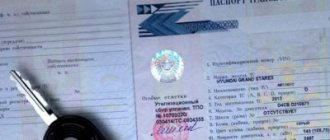Procedure for selling a vehicle by a legal entity
A private citizen or an organization can sell a car. In the first case, the transaction is carried out in a standard way: a purchase and sale agreement is drawn up between the seller and the buyer or a general power of attorney is issued. Payment for the car is made in cash.
If the seller is a legal entity, the situation becomes more complicated. The parties need to draw up a sales contract, and the current owner of the car - the organization - needs to carry out the following procedures:
- The head of the company issues an order to sell the machine. In an LLC, the decision to sell a car is approved by the general meeting of founders. Even if the owner is one person.
- It is required to estimate the cost of the car with the assistance of specialists.
If a transaction occurs between two legal entities, the buyer company also issues a corresponding order.
Reasons for selling a car by a legal entity
Organizations get rid of their own transport in the following circumstances:
- the car needs to be written off as wear and tear reaches a certain level, or its depreciation period ends;
- the company's vehicle fleet was significantly updated, which resulted in an oversupply of transport;
- the company lacks financial resources, and selling the car will help cover the deficit;
- the selling organization no longer needs to use this machine;
- The company is in the process of reorganization or liquidation, so it needs to free up its balance sheet.
Owner in words
Owning a car is not only pleasant and honorable, but also expensive. Moreover, it also requires high responsibility as the owner of a high-risk device. And it is very easy to become such an owner. To do this, it is enough to have rights and obtain verbal consent from the owner. And in any form. You can issue a power of attorney from a notary, or you can simply say: I trust you.
Let us remind you that you can transfer your powers in different ways. You can enter into an agreement on the transfer of a vehicle for temporary possession (rent). You can issue a power of attorney from a notary. You can issue a simple written power of attorney, which does not require a notary's signature. But you can also simply verbally transfer control of the vehicle into the hands of someone who has nothing to do with it.
You must understand that in this case, the one who will be driving must be included in the compulsory third party motor liability insurance policy. This is a kind of confirmation that the driver is a trusted representative of the owner of the car.
If the driver uses a vehicle and at the same time has an open policy in his hands, that is, according to which any driver is allowed to drive, he also does not need a power of attorney. The policy is enough. But in this case we are talking about private individuals. With legal ones, everything is more complicated.
But along with the right to drive a car, such a car owner also receives full responsibility for his actions.
If, while driving a car by proxy, the driver receives a reward, then he is not considered the owner
The accident occurred in August 2014. A certain citizen Lyubishina lost control of the car and it overturned. In the cabin was E. Balbarova, who received serious injuries, and her daughter A. Balbarova, who died. Also in the car was Fedorov, the owner of this car.
Lyubishina, who was driving the car, was found to be the culprit of this incident. However, the criminal case against her was closed. Investigators did not find evidence of a crime under Part 3 of Article 264.
Then the Balbarovs went to court with a claim for compensation for moral damage. For the death of his daughter - in the amount of a million rubles, and for causing grievous bodily harm - in the amount of 500 thousand rubles.
The district court, having established that Lyubishina had a driver’s license and was driving the car in the presence of the owner, considered the demands legal. True, partially. And he exacted compensation in the amount of one million 400 thousand rubles.
But Lyubishina did not agree with this. She stated that she was not the owner of the car, did not drive it on the basis of a power of attorney or on any other legal basis, and therefore was not an appropriate defendant in the case. Responsibility, in her opinion, should be assigned to Fedorov, as the owner. She also indicated that he was drunk in the car at the time of the accident.
The Supreme Court of the Republic of Buryatia agreed with her arguments, pointing out that driving a car on the verbal instructions of the owner does not give grounds to consider her the legal owner of a source of increased danger, and overturned the decision of the district court.
However, the Supreme Court of the Russian Federation did not agree with such arguments, to which Fedorov filed a cassation appeal.
According to paragraph 1 of Article 1079 of the Civil Code, the owner of a high-risk device is obliged to fully compensate for the damage caused. If a power of attorney has been issued for a person to drive a vehicle, then he is recognized as its legal owner when the car is transferred to him for temporary use and he uses it at his own discretion.
However, there is one exception. If the responsibilities of the person for whom the power of attorney was issued only include driving a car in the interests of another person, and for this he is paid remuneration (driving services), such a person is not considered the owner of a source of increased danger.
In addition, now, according to the Traffic Rules, the driver is not required to have a power of attorney to drive a car.
Thus, the Supreme Court decided, by driving a vehicle without a written power of attorney, but with a driver’s license and in the presence of the owner, Lyubishina was using the car legally.
At the same time, the Supreme Court noted, the lower court did not examine the issue of her provision of driving services, and no other grounds were established for releasing Lyubishina from liability for harm caused.
Therefore, the appeal ruling of the judicial panel for civil cases of the Supreme Court of the Republic of Buryatia is illegal and subject to cancellation, the Supreme Court of the Russian Federation ruled.
The case was sent for a new trial to the appellate court.
Transaction procedure
The sale of a car by a legal entity to a private citizen takes place in several stages:
- The parties draw up a purchase and sale agreement. The document must contain information about the legal entity and personal data of the buyer, the cost of the vehicle and other important nuances.
- Payment is being made. By agreement, the buyer can deposit money into the organization’s current account, or transfer it personally to a representative of the company.
- An act of acceptance and transfer of the vehicle is drawn up.
- The buyer applies to the traffic police department to register the vehicle with the state. As a result, information about the new owner is entered into the car’s title.
The buyer of the vehicle is required to sign a purchase and sale agreement, deposit money and register the vehicle with the state. The procedure for buying and selling a vehicle between an organization and a private citizen is similar to that between two individuals. The difference is that the seller - a legal entity - needs to issue an appropriate order.
Filling out the purchase and sale agreement
Both parties to the transaction must agree with the contents of the vehicle purchase and sale agreement. Usually, to save money, a standard sample agreement is used. However, the law does not prohibit filling out documents with your own clauses. This is done to remove possible legal consequences. When filling out a contract when selling a car by a legal entity, you should adhere to the following instructions:
- Initially, a description of the car is made. It is necessary to record detailed information about the car on paper. Then information is entered about the form of ownership of the former owner of the car, as well as existing restrictions. The information is included in the registration certificate.
- In the second and third sections, essential conditions must be entered. Here the exact cost is fixed, the amount of VAT is indicated, the period within which the calculation must be made, as well as the procedure for its implementation, is prescribed. Additionally, the possible liability that occurs if the terms of the agreement is violated is indicated. Obligations for registration actions are also recorded there.
- The conclusion records information about the absence of restrictions preventing the sale. Additionally, the details of the parties are entered.
Selling Features
Before signing the purchase and sale agreement, the buyer is advised to check the legal integrity of the company. Otherwise, you may be left without a car and without money.
First, you need to find out why the company sells a fleet of vehicles, whether it is in conflict with the law, and whether it pays taxes regularly. All information can be found on the Internet. The buyer needs to check:
- The presence of legal claims against the seller.
- His tax payments. The official website of the Federal Tax Service is used for this.
- Availability of enforcement proceedings. To help - the web resource of the FSSP of the Russian Federation.
- Business reputation. To find out this information, just enter the company name into any search engine.
The next step is to check the car itself. A potential buyer can make inquiries about the vehicle using the following databases:
- traffic police;
- FSSP - check the owner of the vehicle for debts;
- Verification sites checking VIN number;
- Pledge registry.
How can an individual buy a car from a legal entity?
There may be several options for individuals to purchase a vehicle from a legal entity:
- Purchasing a new car at a car dealership.
- Purchasing a used vehicle that the organization is selling as unnecessary.
In this case, there are no fundamental differences from a standard purchase and sale transaction. The procedure is carried out according to the usual scheme described in the Civil Code of the Russian Federation. There are only two nuances that distinguish this type of relationship:
- the need to check the seller for legal purity;
- additional documents when drawing up the contract.
Documentation
At the end of the transaction, the buyer must receive the following papers:
- a copy of the purchase and sale agreement;
- PTS and STS cars;
- inspection card.
The seller is not obliged to transfer the MTPL policy to the buyer. The new owner of the car draws up a document in his name.
Car purchase and sale agreement
There is no need to deregister the vehicle and notarize the purchase and sale agreement.
If the owner wants to keep the previous license plates in order to use them on a new car, he must submit an application to the traffic police. In this case, the license plates will be stored by the traffic police for 180 days.
The execution of an agreement between legal entities and individuals is carried out in accordance with standard requirements. The section where the seller is indicated must contain all significant details of the current owner of the vehicle. The individual signs the agreement, and the enterprise puts the stamp and signature of the head of the institution on it.
How do you pay?
The buyer can transfer funds to a legal entity in only two ways:
- through the organization's cash desk;
- transfer to a bank account.
If a legal entity does not have a cash register and cannot issue a check, then there is only one payment option left - to a current account . For this, receipt PD-4 is used; it contains information about the sender of the payment, its purpose and the number of the purchase and sale agreement. The accountant of the legal entity reflects the amount received as net profit.
Registration of vehicles with the traffic police
The fact that the car is purchased from an enterprise and not from a private individual does not change the scheme for registering it with the State Traffic Inspectorate.
The new owner has 10 days to register the vehicle. You need to bring to the traffic police department:
- application for state registration of the car;
- applicant's passport;
- vehicle registration certificate;
- technical inspection report;
- purchase and sale agreement;
- OSAGO insurance policy.
The vehicle registration service is paid - 2000 rubles. A receipt confirming the fact of depositing funds must be submitted simultaneously with the application. You can make an appointment with the traffic police through the Gosuslugi.ru portal.
Differences when buying a new and used car
A common case of an individual purchasing a new car from a legal entity is concluding a transaction at a car dealership. This procedure looks like this:
- selection of brand and model. Receiving advice from the salon manager;
- choice of configuration, color and other options;
- inspection of the selected option, test drive;
- conclusion of an agreement, payment of funds for a car;
- receipt of all documents and the car itself.
Among the distinctive features of purchasing a new car are:
- Possibility to choose brand, model, color and configuration.
- Additional protection of the transaction thanks to the consumer rights law.
- Possibility of receiving additional bonuses, but no bargaining.
- Registration of all documents for a car in one place. The buyer does not need to visit the traffic police and the insurance company.
You can purchase a used car either at a car dealership (the procedure will be similar to that described above), or from another legal entity that is not involved in the sale of vehicles. The reason for selling a car may be:
- the end of its depreciation period;
- renewal or reduction of the vehicle fleet;
- receiving funds that will be used to repay debts to creditors.
Stages of a transaction for purchasing a used car from a legal entity:
- Visual inspection of the vehicle and checking it against databases (for collateral, theft).
- Drawing up a purchase and sale agreement.
- Payment at the organization's cash desk or by transferring funds to a bank account.
- Drawing up a car acceptance certificate.
- Receiving a package of documents (STS, PTS) and handing over the car itself.
Distinctive features of such a deal:
- the need for additional checks of a used car;
- the need to visit the traffic police department for registration and the insurance company to issue an MTPL policy.











